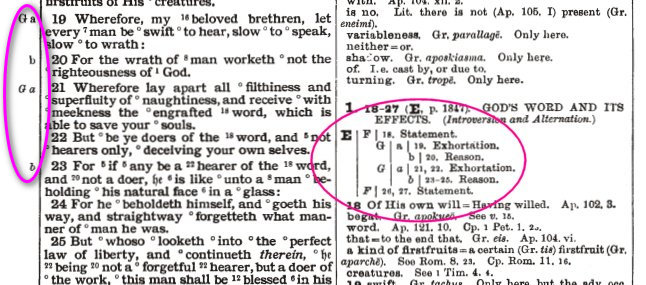Bible Code Revelations - Thematic Patterns Expose Riddles
One of the methods of Bible study I have learned to enjoy is technical but, fundamentally, isn't really very difficult to understand. It has to do with gaining special insight into the context. Most people don't realize that linguistic patterns are inherent in the holy scriptures. Have you ever read the Bible and observed how repetitious some passages are? The Author was not being verbose or flowery to merely embue the holy scriptures with a poetic or lyrical quality. The repetition of words and themes form patterns that are beautifully symmetrical. By means of these structures that are woven into the full range of biblical text, the Author actually conveys emphasis and even profound insight to the diligent student! These thematic patterns are a rich expression of context!
This clever encryption methodology survives the translation of the original languages! Scholars refer to this facet of the scriptures as chiasm, chaismus, parallelism, and Hebrew poetry, in the field of discourse analysis and text linguistics.
This is not for those who like to be "fed through a straw," so to speak, but for those who are skilled with a fork and knife. A student's diligent effort in seeking the Author's help in the analysis of these thematic patterns may result in added insight, even the unlocking of profound mysteries through the Author's own invaluable guide to interpretation. Think about this for a moment. Context is necessary to interpret and understand most everything in life. This is really is all about context.
 I didn't discover this underlying structure. It's been studied by some for a long time. Why haven't you ever heard of such a thing? Renowned scholar E.W. Bullinger pondered this, making the following observation in his work titled, The Scope of a Passage May Best Be Discovered by Its Structure.
I didn't discover this underlying structure. It's been studied by some for a long time. Why haven't you ever heard of such a thing? Renowned scholar E.W. Bullinger pondered this, making the following observation in his work titled, The Scope of a Passage May Best Be Discovered by Its Structure.
class="quoted">"While the successive works of Bishops Lowth and Jebb were enthusiastically and generally received, yet the works of Thomas Boys not only had to fight their way through much opposition, but are now practically unknown to Biblical students. Whether it is because they afford such a wonderful evidence of the supernatural and miraculous in the Bible, and such a proof of the Divine Authorship of the Word of God, that they are therefore the special object of attack by the enemies of that Word (both Satanic and human) He alone knows. But so it is."
I have no doubt that what he rightly considers evidence and proof is still today practically unknown to Biblical students because it is as he suggested, "the special object of attack by the enemies of that Word." Acknowledging the greater purposes of the sovereign God, whose purposes are surely being served, the perceived lack of appropriate recognition is a witness to the Lord's own protection of the matter. I worked in the information security world where such a thing has been described as "security through obscurity" or "security by obscurity." This practice isn't recommended as the only line of defense, but there's no doubt that hiding a thing provides a degree of protection. The Divine author has encrypted riddles and their answers in such a way that their very existence escapes the notice of the vast majority of those who come to the Bible!

Bullinger provides many examples of structure in his Companion Bible. Since the time of John Jebb and Thomas Boys, which Bullinger drew upon, others have published works in this genre, like Nils Lund in the 1920s. When I was first introduced to this work in 1980 or '81 I found the structures fascinating and inspiring. At one point, I inquired of my former teachers about what they were for and was told that they were interesting but that they were not useful for interpretation. I tried to accept that answer out of respect, but really, that just never set right with me. Some time later, when the Lord took me to His feet for some reeducation, which was sorely needed, I discovered that structural analysis was actually an essential in His personal curriculum for me.
You'll find a listing of resources with links on this page, on our promotional website for the app used to develop the interactive presentation below right. (Chiasmatron 2000)
Here on The Open Scroll, there are many unique presentations of this kind. Hover your mouse over this example from the first chapter of Genesis slowly to explore the pattern. (If you're using a tablet or smartphone you can interact by tapping on the bars and lines of text.)
Around 60 interactive presentations may be found in our page dedicated to Interactive Content. They range in scale from the very small to the very large (with up to eight consecutive chapters in a connected sequence) in examples from the Old and New Testaments, in English, Greek, Hebrew, and Russian.
Many of the matching elements in these thematic structures are pretty easily compared. For those pairings where the common theme is not so readily apparent, we can still be confident in knowing they are truly paired because of the symmetry of the context. The more obvious comparisons help guide us to the more subtle.
If you're saying, "I don't get it," pray and come back when you're ready. You may perhaps enlist the aid of some friends who enjoy a good puzzle.
Once we can confidently identify paired elements and agree that they are divinely matched, we have learned something very important about the context. One element is divinely paired with another, and together they bear witness on a common theme. If the matching doesn't make sense to you on one level of understanding, the relationship will be found to exist on another, which is often a deeper, more profound level of truth. We're drawn in by this curiosity by the Lord Himself through the holy spirit to discover His secrets.
It is the glory of God to conceal a matter, but the glory of kings is to search out a matter.
Proverbs 25:2
To illustrate the importance of context, consider this simple example. If we're having a conversation and I tell you, "It's blue," what have you just learned? Not much. What is it that is blue? I haven't explained what "it" is, so you can only guess. If our conversation was all about my new coat, it would be obvious what was meant. I could have said, "My new coat is blue," but if we're having a conversation about it I can simply make reference with a pronoun and pretty safely assume that you'll infer from the context what's meant. When I communicate by making such a reference I'm making an implication. "It's blue" is not going to refer to something foreign to the context of our conversation. If you've got a sound mind, you're not going to reach outside that context for the meaning.
If the subject has more than one level of meaning, as common to the biblical text, the matter being referenced may be esoteric but, even still, the context is going to be specific. The Lord has concealed essential information about the context from the casual reader by requiring that the thematic structure is properly discerned, and further, that deeper insight into the subject matter has been acquired. When the refined context is exposed through much effort and seeking of the Lord, we gain the advantage of learning precisely which pond must be fished, so to speak.
I think of this like as if I was fishing. If I'm fishing in a bass pond, I'm going to catch bass. I'm not going to catch trout. When it comes to most of what passes for sound Bible teaching, folks have long been accustomed to all manner of theological sleight of hand, where all manner of strange fish are pulled out of random ponds for lack of respect for the context established by the Author Himself, and, truly, for the Author Himself.
To say that this matter of context has been underemployed by students of the Bible as a guide to interpretation would be a massive understatement. No one who gives it their attention can deny that these patterns exist. No one exercising the least bit of common sense would see these patterns and suggest they have no utility as a guide, because meaning depends upon context. Thematic structure defines the context, does it not? To ignore it, then, when one seeks to learn the Truth, is foolishness, to the extreme, yet, that's what the church has done by failing to give it due respect.
Are scholars ignorant of this exhibit of the handiwork of the divine Author? No. Can all the blame for our ignorance be laid upon a few men? No, quite honestly. How many copies of the Companion Bible are in circulation, each of which bears witness to this structure throughout? In our readings of the scriptures, has it never been impressed upon you that there might be some purpose to the repetitions beyond the superficial impartation of a sense of prose?
15 and regard the patience of our Lord as salvation; just as also our beloved brother Paul, according to the wisdom given him, wrote to you, 16 as also in all his letters, speaking in them of these things, in which are some things hard to understand, which the untaught and unstable distort, as they do also the rest of the Scriptures, to their own destruction.
2 Peter 3:15-16
Again, around 60 interactive presentations may be found on our Interactive Content page. We recommend becoming familiar with them, meditating upon these patterns as the Lord may lead.
Tips
For some of the larger scale presentations, smaller screen sizes and resolutions present some challenges to getting the most benefit. Because the obvious solution is to increase the screen size, using a large monitor in portrait mode (rotated so it is taller than it is wide) is recommended, like this 24 inch monitor that can be rotated 90 degrees. A 27 incher or a vertical stack of thin bezel monitors would be even better, or a HD projector and giant screen like those found in many churches, corporate conference rooms and lecture halls. Most browsers can display in full-screen mode. Try F11.
Opening the presentation in two browser windows can help when the entire presentation doesn't fit within your screen height. With separate windows, the hover highlighting in one won't influence the other, of course, but that's not an obstacle if you're clever. (zoom out - will often allow you to discover the mouseover highlited pairing) The windows could be arranged side by side but it might be even more useful to go with an over-under arrangement. Scroll and zoom each until everything you want to compare is nicely in view. I recommend using two different kinds of browsers for these windows, like Chrome and Opera for example. This way, you can resize the text in one window independently of the other. The keyboard shortcut F11 will make browsers like Chrome and Opera toggle in and out of full screen mode, which makes the tabs, address bars and button bars come and go. Other useful keyboard commands are for refreshing (F5) and zooming (ctrl-plus and ctrl-minus - To return to default size: ctrl-zero).
In closing, on a similar line, here's a comparison between John 13 and Revelation 13 and 14 - Comparing Thirty-Eight Verse Pairs
I pray that you will find inspiration to seek the Lord about what He might have for you in this, in this hour of the age that is now, oh, so late.